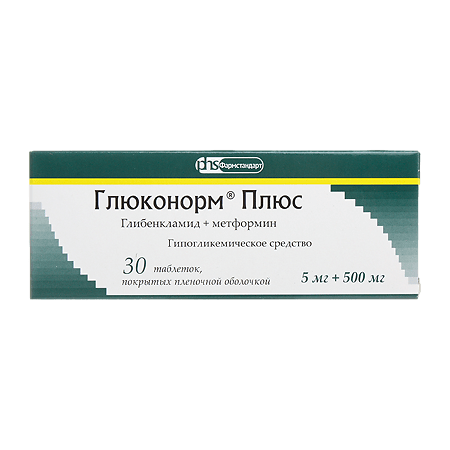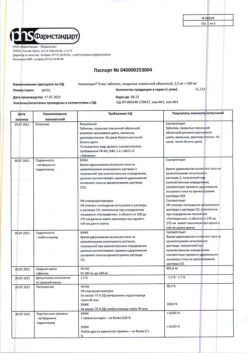No products in the cart.
Glukonorm plus, 5 mg+500 mg 30 pcs
€11.35 €9.45
Out of stock
(E-mail when Stock is available)
Description
Oral hypoglycemic agent (second generation sulfonylurea derivative + biguanide)
Indications
Indications
Type 2 diabetes mellitus in adults:
– if diet therapy, physical exercise and previous monotherapy with metformin or sulfonylurea derivatives are ineffective;
– to replace previous therapy with two drugs (metformin and sulfonylurea derivatives) in patients with stable and well-controlled glycemic levels.
Pharmacological effect
Pharmacological effect
Hypoglycemic agent for oral use (second generation sulfonylurea derivative + biguanide)
Special instructions
Special instructions
During treatment with Gluconorm® Plus, it is necessary to regularly monitor fasting and postprandial blood glucose levels. Lactic acidosis Lactic acidosis is an extremely rare but serious (high mortality rate in the absence of emergency treatment) complication that can occur due to the accumulation of metformin.
Active ingredient
Active ingredient
Glibenclamide, Metformin
Composition
Composition
Active ingredients:
glibenclamide – 5.00 mg,
metformin hydrochloride – 500 mg.
Excipients:
microcrystalline cellulose – 57.20 mg,
hyprolose (hydroxypropylcellulose) – 13.80 mg,
croscarmellose sodium – 18.00 mg,
magnesium stearate – 6.00 mg.
Shell for 5 mg + 500 mg dosage:
VIVACOAT® РМ-2Р-050 [hypromellose (hydroxypropyl methylcellulose 6 cP) – 9.00 mg, hyprolose (hydroxypropylcellulose) – 0.90 mg, polyethylene glycol 3350 – 0.90 mg, gitanium dioxide – 4.75 mg, talc – 1.80 mg, iron oxide yellow dye (E172) – 0.26 mg, quinoline yellow dye (E104) – 0.37 mg, sunset yellow dye (E110) – 0.02 mg] – 18.00 mg.
Pregnancy
Pregnancy
The use of the drug is contraindicated during pregnancy.
Contraindications
Contraindications
– Hypersensitivity to metformin, glibenclamide or other sulfonylurea derivatives, as well as to excipients;
– diabetes mellitus type 1;
– diabetic ketoacidosis, diabetic precoma, diabetic coma;
– renal failure or impaired renal function (creatinine clearance less than 60 ml/min);
– acute conditions that can lead to changes in kidney function: dehydration, severe infection, shock, intravascular administration of iodine-containing contrast agents (see “Special Instructions”);
– acute or chronic diseases that are accompanied by tissue hypoxia: cardiac or respiratory failure, recent myocardial infarction, shock;
– liver failure;
– porphyria;
– pregnancy, breastfeeding period;
– simultaneous use of miconazole;
– extensive surgical operations;
– chronic alcoholism, acute alcohol intoxication;
– lactic acidosis (including history);
– adherence to a hypocaloric diet (less than 1000 cal/day).
It is not recommended to use the drug for persons over 60 years of age who perform heavy physical work, which is associated with an increased risk of developing lactic acidosis.
With caution:
Feverish syndrome, adrenal insufficiency, hypofunction of the anterior pituitary gland, diseases of the thyroid gland with uncompensated impairment of its function.
Side Effects
Side Effects
During treatment with Gluconorm® Plus, the following side effects may occur.
Side effects are presented depending on the effect on organs and organ systems.
The following adverse events noted when using the drug Gluconorm® Plus are distributed according to the frequency of occurrence in accordance with the following gradation: very often (≥ 1/10), often (≥ 1/100 to 1/10), infrequently (≥ 1/1000 to < 1/100), rarely (≥ 1/10000 to < 1/1000), very rarely (< 1/10000).
Within each group, adverse effects are presented in order of decreasing severity.
Metabolism and nutrition:
Hypoglycemia (see “Overdose”, “Special instructions”).
Rarely: attacks of hepatic porphyria and cutaneous porphyria.
Very rare: lactic acidosis (see “Special Instructions”).
Decreased absorption of vitamin B12, accompanied by a decrease in its concentration in the blood serum with long-term use of metformin. When megaloblastic anemia is detected, the possibility of such an etiology must be taken into account. Disulfiram-like reaction when drinking alcohol.
Laboratory indicators:
Uncommon: moderate to moderate increases in serum urea and creatinine concentrations.
Very rare: hyponatremia.
From the blood and lymphatic system:
Rarely: leukopenia, thrombocytopenia.
Very rare: agranulocytosis, hemolytic anemia, bone marrow aplasia and pancytopenia.
These adverse events disappear after discontinuation of the drug.
From the nervous system:
Common: taste disturbance (metallic taste in the mouth).
On the part of the visual organ: at the beginning of treatment, temporary visual impairment may occur due to a decrease in blood glucose.
From the gastrointestinal tract:
Very common: nausea, vomiting, diarrhea, abdominal pain and lack of appetite. These symptoms are more common at the beginning of treatment and in most cases go away on their own. To prevent the development of these symptoms, it is recommended to take the drug in 2 or 3 doses; Slowly increasing the dose of the drug also improves its tolerability.
From the side of the track and subcutaneous tissues:
Rarely: skin reactions such as: itching, urticaria, maculopapular rash.
Very rare: cutaneous or visceral allergic vasculitis, erythema multiforme, exfoliative dermatitis, photosensitivity.
From the immune system:
Very rare: anaphylactic shock.
Cross-hypersensitivity reactions to sulfonamides and their derivatives may occur.
From the liver and biliary tract:
Very rare: abnormal liver function tests or hepatitis requiring discontinuation of treatment.
Interaction
Interaction
Contraindicated combinations
Associated with the use of glibenclamide
Miconazole can provoke the development of hypoglycemia (up to the development of coma).
Associated with metformin use
Iodinated contrast media: Depending on renal function, the drug should be discontinued 48 hours before or after intravenous administration of iodinated contrast media.
Combinations not recommended
Related to the use of sulfonylurea derivatives
Alcohol: a disulfiram-like reaction (alcohol intolerance) is very rarely observed when taking alcohol and glibenclamide simultaneously. Alcohol intake may increase the hypoglycemic effect (by inhibiting compensatory reactions or delaying its metabolic inactivation), which may contribute to the development of hypoglycemic coma. During treatment with Gluconorm® Plus, you should avoid taking alcohol and medications containing alcohol. Phenylbutazone increases the hypoglycemic effect of sulfonylurea derivatives (by replacing sulfonylurea derivatives at the sites of their binding to protein and/or reducing their elimination). It is preferable to use other anti-inflammatory drugs that exhibit lesser effects, or to warn the patient about the need to self-monitor glycemic levels; If necessary, the dose should be adjusted when using an anti-inflammatory drug together and after its discontinuation.
Associated with the use of glibenclamide
Bosentan in combination with glibenclamide increases the risk of hepatotoxicity. It is recommended to avoid taking these drugs together. The hypoglycemic effect of glibenclamide may also be reduced.
Associated with metformin use
Alcohol: The risk of developing lactic acidosis increases with acute alcohol intoxication, especially in cases of fasting or poor nutrition, or liver failure. During treatment with Gluconorm® Plus, you should avoid taking alcohol and medications containing ethanol.
Combinations requiring caution
Associated with the use of all hypoglycemic agents
Chlorpromazine: in high doses (100 mg/day) causes an increase in glycemic levels (reducing insulin release).
Precautions: the patient should be warned about the need to independently monitor blood glucose levels; If necessary, the dose of the hypoglycemic agent should be adjusted during simultaneous use of the antipsychotic and after discontinuation of its use.
Glucocorticosteroids (GCS) and tetracosactide: an increase in blood glucose levels, sometimes accompanied by ketosis (GCS cause a decrease in glucose tolerance).
Precautions: the patient should be warned about the need to independently monitor blood glucose levels; if necessary, the dose of the hypoglycemic agent should be adjusted during the simultaneous use of GCS and after discontinuation of their use.
Danazol has a hyperglycemic effect. If treatment with danazol is necessary and when taking the latter, a dose adjustment of Gluconorm® Plus is required under the control of glycemic levels.
β2-adrenergic agonists: by stimulating β2-adrenergic receptors, they increase the concentration of glucose in the blood.
Precautions: it is necessary to warn the patient and establish control of blood glucose levels; transfer to insulin therapy is possible.
Diuretics: increase blood glucose levels.
Precautions: the patient should be warned about the need to independently monitor blood glucose levels; It may be necessary to adjust the dose of the hypoglycemic agent during simultaneous use with diuretics and after discontinuation of their use.
Angiotensin-converting enzyme (ACE) inhibitors (captopril, enalapril): the use of ACE inhibitors helps reduce blood glucose. If necessary, the dose of Gluconorm® Plus should be adjusted during simultaneous use with ACE inhibitors and after discontinuation of their use.
Associated with metformin use
Diuretics: lactic acidosis that occurs when taking metformin against the background of functional renal failure caused by taking diuretics, especially loop diuretics.
Associated with the use of glibenclamide
β-blockers, clonidine, reserpine, guanethidine and sympathomimetics mask some symptoms of hypoglycemia: palpitations and tachycardia; Most non-selective beta-blockers increase the incidence and severity of hypoglycemia.
The patient should be warned about the need to independently monitor blood glucose levels, especially at the beginning of treatment.
Fluconazole: increased half-life of glibenclamide with the possible occurrence of hypoglycemia. The patient should be warned about the need to self-monitor blood glucose levels; It may be necessary to adjust the dose of hypoglycemic drugs during concomitant treatment with fluconazole and after discontinuation of its use.
Bile acid sequestrants: Concomitant use with Gluconorm® Plus reduces the concentration of glibenclamide in the blood plasma, which can lead to a decrease in the hypoglycemic effect. Gluconorm® Plus should be taken at least 4 hours before taking bile acid sequestrants.
Other Interactions: Combinations to Consider
Associated with the use of glibenclamide
Desmopressin: Glibenclamide may reduce the antidiuretic effect of desmopressin.
Antibacterial drugs from the group of sulfonamides, fluoroquinolones, anticoagulants (coumarin derivatives), monoamine oxidase inhibitors (MAO), chloramphenicol, pentoxifylline, hypolipidermic drugs from the group of fibrates, disopyramide – the risk of developing hypoglycemia during the use of glibenclamide.
Overdose
Overdose
In case of overdose, hypoglycemia may develop due to the presence of a sulfonyl urea derivative in the composition of the drug (see “Special Instructions”).
Mild to moderate symptoms of hypoglycemia without loss of consciousness or neurological manifestations can be corrected by immediate consumption of sugar. It is necessary to adjust the dose and/or change the diet. The occurrence of severe hypoglycemic reactions in patients with diabetes mellitus, accompanied by coma, paroxysm or other neurological disorders, requires emergency medical care. Intravenous administration of dextrose solution is necessary immediately after diagnosis or suspicion of hypoglycemia before hospitalization of the patient. After regaining consciousness, it is necessary to give the patient food rich in easily digestible carbohydrates (to avoid re-development of hypoglycemia).
Long-term overdose or the presence of associated risk factors can provoke the development of lactic acidosis, since the drug contains metformin (see “Special Instructions”).
Lactic acidosis is a medical emergency; Lactic acidosis should be treated in a clinic. The most effective treatment method for removing lactate and metformin is hemodialysis.
Plasma clearance of glibenclamide may be increased in patients with liver disease. Since glibenclamide actively binds to blood proteins, the drug is not eliminated during dialysis.
Storage conditions
Storage conditions
At a temperature not exceeding 25 °C.
Keep out of the reach of children.
Shelf life
Shelf life
2 years. Do not use after the expiration date stated on the package.
Manufacturer
Manufacturer
Pharmstandard-Leksredstva, Russia
Additional information
| Shelf life | 2 years. Do not use after the expiration date stated on the package. |
|---|---|
| Conditions of storage | At a temperature not exceeding 25 ° C. Store out of the reach of children. |
| Manufacturer | Pharmstandard-Leksredstva, Russia |
| Medication form | pills |
| Brand | Pharmstandard-Leksredstva |
Other forms…
Related products
Buy Glukonorm plus, 5 mg+500 mg 30 pcs with delivery to USA, UK, Europe and over 120 other countries.
















